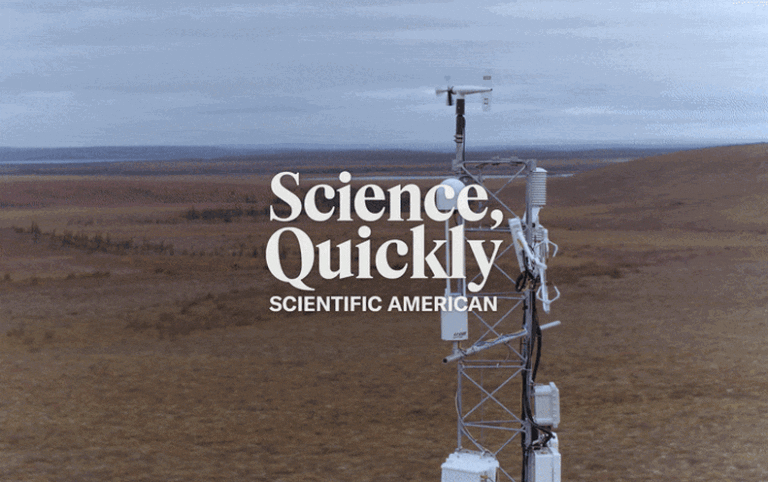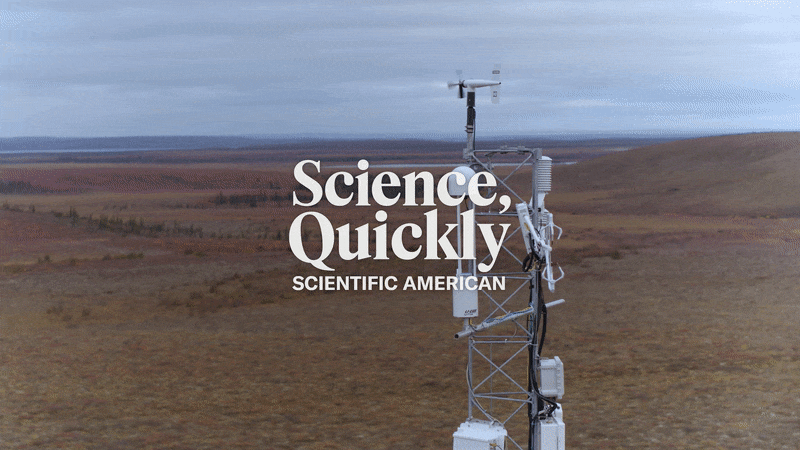
[ad_1]

Jocie Bentley (tape): PSA: don’t bring hiking boots when walking the tundra. Your feet will get soaked like a wet sponge.
Gabriel Hould Gosselin (tape): Almost there. [laughs] About halfway. Well, it’s a lot faster with snowmobiles.
Bentley: Hey, I’m Jocie Bentley, and this is the final episode of a three-part Science, Quickly Fascination series from a fast-warming Arctic.
Today I’m heading to a place called the Trail Valley Creek Research Station, high in the Canadian Arctic. I’m sloshing along with Gabriel Hould Gosselin. Gabriel is a research assistant for Wilfrid Laurier University in Ontario and the University of Montreal.
We actually did his original interviews in French, so you are listening to a combination of field audio and a new interview in English.
Gosselin: Alright, so I brought you about 60 kilometers north of Inuvik, which is a little town at the top of the Northwest Territories, out near the Tuktoyaktuk highway in the tundra.
Bentley: We passed the tree line on our drive. No more trees, just a flat carpet of orange and red tundra, covering softly rolling hills. It’s unlike any landscape I’ve ever seen.
Gosselin: There’s permafrost all over the place. It’s super deep. It’s, like, four- to 600 meters, depending, deep.
Bentley: So for all you non-Metric listeners, that’s 1,300 to almost 2,000 feet deep. That’s deeper than almost all of the world’s tallest skyscrapers.
Gosselin: And that’s permafrost being permanently frozen ground, ground that doesn’t go above zero degrees Celsius. Of course, the top layer kind of thaws over summer and then refreezes over winter.
Bentley: And that is exactly the part that Gabriel is most interested in.
Gosselin: That’s the area that is active, that has bacteria kind of decomposing organic matter and farting out carbon dioxide and methane …
Bentley: [Laughs]
Gosselin: I mean, there’s this kind of methane bomb. That’s what people are thinking about, and thinking …
Bentley: The more there is, the more trouble we’re in.
Gosselin: Oh, boy, if things keep on warming, there’s a whole bunch of ground that’s been frozen for a long time with basically a huge pool of carbon that’s just ready to be digested by those methane-producing bacteria.
Bentley: And that’s a huge concern for researchers such as Gabriel.
Gosselin: What’s going to happen? And that’s, that’s a concern. What’s going on in the Arctic?
Bentley: And that’s why he’s here. There’s only one way to learn the answer to that question, and it’s with data.
Gosselin: There’s been very little real sampling that’s been done. I mean, there’s more and more stuff that comes out. There’s more and more satellites that are put out there that are much better and better at looking at different wavelengths. Some of them use radar. Some of them use infrared. Some of them actually see, measure directly, the amount of methane that’s in the air in certain areas.
Bentley: But those methods are less reliable without actual measurements from the ground.
Gosselin: To validate those measurements, we need ground-truthing data, so, data that comes from the area that that satellite’s looking at to kind of compare what’s being measured and from up there and then what’s being measured from the ground.
Bentley: And that’s why we’re standing among a bunch of white tents on red tundra. It’s all cleaned up for the offseason.
Bentley (tape): Is it not normally this clean?
Gosselin: I mean, normally there’s a bunch of people living here, so there’s stuff everywhere.
Uh, normally we have a bug net, like, uh, one of those, uh, kind of gazebo bug net things. Yeah. And then we set up tents all around here. I mean, normally there’s a whole bunch of chairs, and, uh, you know, when we get a heater going, people kind of, it’s where we eat and just spend our time. It’s tea! And it’s nice and clean.
Bentley: We make our way to Gabriel’s main research station. It’s called an eddy covariance tower.
Gosselin: A private company installed the tower. I just installed the instruments on it. Yeah, I spent 30 hours on it.
Bentley: So he climbed 20 meters, or 65 feet, up this skinny tower carrying giant pieces of equipment. Here’s what he installed.
Gosselin: So on the tower for eddy covariance, in principle, there’s two main instruments: one instrument that measures the concentration of gas that we’re interested in in the air and [another] that uses infrared.
Bentley: Remember those greenhouse gas farts? This is how science “sniffs” them out.
Gosselin: So basically, we know, per volume, the amount of carbon dioxide or water vapor that’s in that parcel there. And we’re using ultrasound to measure it about 10 times a second—the speed of wind and the X, Y and Z direction. And then we do the covariance between the vertical movements of wind and the concentration of gas.
Bentley (tape): Do we have enough towers in the North to get an accurate picture?
Gosselin (tape): No, we do not. It’s incredibly difficult and costly to just get something out there. Just to go in those environments is really expensive. The biggest challenge that I found doing stuff out there is not necessarily the cold or, like, the mosquitoes or whatever. It’s getting enough power for all of those instruments that measure 24 hours a day, 10 times a second.
Bentley: Is tundra really that different that we need testing in all these different locations? How does it differ?
Gosselin (tape): You try to draw, like, not a paint-by-numbers but, you know, one of those little, and then you have to kind of draw a line.
Bentley (tape): Connect the dots!
Gosselin (tape): Yeah. But basically, you get an entire image with four points, and you have to draw an elephant. Like, it’s not going to look like an elephant. It’s going to look like a square.
So it’s the same thing. Like, you’re trying to get a detailed image of what, like, how different types of landscapes in the North behave. But if we only have four points, we’re going to be missing a lot of detail, and maybe some of the details are going to be important.
Bentley: How big of a problem is this? How worried should we be?
Gosselin: There’s been very little real sampling that’s been done. I don’t want to be alarmist. There’s always the kind of trap for scientists. They just go, “Well, I don’t know. I’m not qualified enough.” And then basically that’s taken, um, by the media saying, “Well, we’re not sure whether it’s a problem.”
Of course it’s concerning. Of course we have to do something. In fact, we’re past the point of no return. Things are going to happen. Things are warming up already beyond our control. And the consequences of that are happening now and are going to happen. By how much, I can’t say.
Bentley: Science, Quickly is produced by Jeffrey DelViscio, Tulika Bose and Kelso Harper. Our music was composed by Dominic Smith. Like and subscribe wherever you get your podcasts. And for more science news, please go to ScientificAmerican.com.
This podcast was produced in partnership with Let’s Talk Science.
Thanks for joining us for our Arctic series. I’m Joc Bentley, and this is Science, Quickly.
Funding for this story was provided in part by Let’s Talk Science, a charitable organization that has provided engaging, evidence-based STEM programs for 30 years at no cost for Canadian youth and educators
[ad_2]